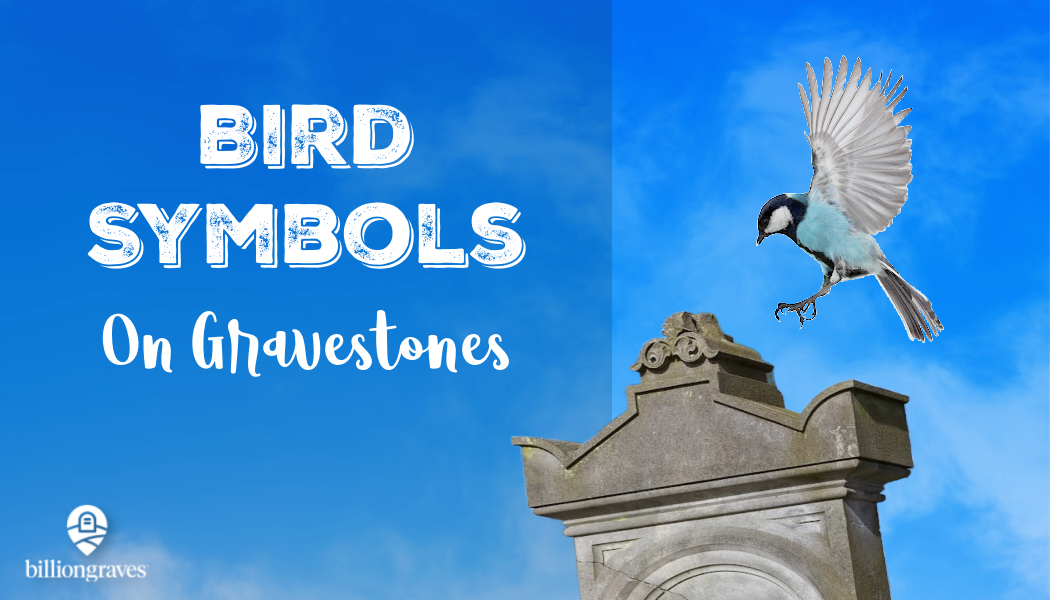Bird symbols at the cemetery give us clues about what our ancestors thought and what they valued. Once you start to pay attention to this, you may be surprised at how many birds you will see on gravestones during your visits to the cemetery.
My First Lost Love
My very first experience with losing someone I loved occurred when I was about five years old. It was the passing of our blue parakeet named ‘Petey’. (Okay, maybe you wouldn’t call him a “someone” but to me, at age 5, he was a very important “someone”.)

When we first got Petey, his cage was stationed next to our family telephone (and my mother kept our telephone QUITE busy). So it wasn’t long before Petey learned to say, “hello”. He said it all day long. And all night long too. My parents learned that they had to cover his cage at night or he would just talk 24/7.
One night my parents went out for the evening, forgetting to cover Petey’s cage. Ut-oh. The babysitter was shaking by the time they returned, thinking that a burglar was lurking around just out of sight, saying “hello” to her over and over.
Petey even learned to say our names, calling out to my little brothers, “Hello Bobby” and “Hello David”. My name must have been hard for a parakeet to pronounce so “Hello, Cathy” came out more like “Hello, Cotty”. (I’ll take it.)

Then one day Petey didn’t talk. He didn’t move. He had passed over the birdy rainbow to the great unknown. My mother helped us make a little coffin out of a shoebox and our cousins were invited to the birdy funeral.
About an hour later, my mother noticed that my younger brother, David, was too quiet. (All mothers know what that means.) She found him digging up the bird coffin shoebox. When she asked him why, he said that he was just checking to see if Petey had gone to heaven yet.
Bird Symbols from Ancient to Modern Times
Gravestones with bird symbols can be found throughout history. Bird symbols can be found in Biblical stories, ancient Egypt, and medieval times.
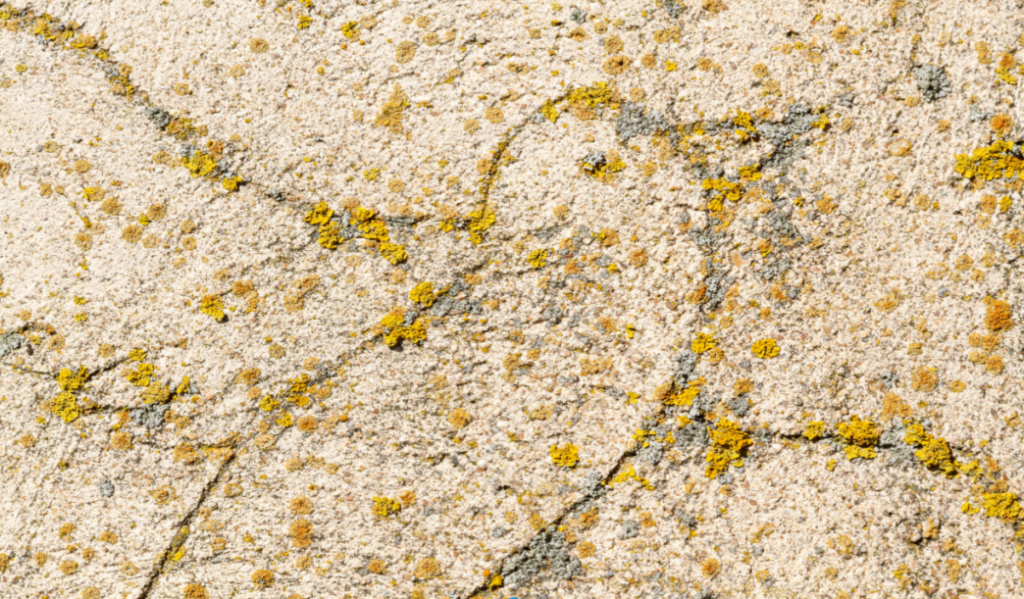
Birds are even featured prominently in our modern-day idioms and phrases. The proverb ‘A bird in the hand is worth two in the bush’ means that it’s better to hold onto something you have rather than take the risk of getting something better which may come to nothing.
Here are some others:
- A box of birds (very noisy)
- A chicken in every pot (no one is going hungry)
- A good egg (an honest person)
- A little bird told me (a secret was shared)
- As happy as a lark (someone who is joyful and carefree)
- As mad as a wet hen (someone who is very angry)
- As the crow flies (traveling in a straight line)
- Bird brain (not very smart)
- Cold turkey (quitting an addiction suddenly)
- Early bird gets the worm (someone who shows up early gets rewarded)

But why did some of our ancestors put birds on their gravestones? Let’s take a look at some examples.
Bird Symbols: Birds in Flight

Birds in flight are sometimes seen on adult gravestones but are more often symbols on children’s gravestones. They represent a spirit that has left the body.

This double gravestone is for a mother and her baby. The mother was just 22 years old. The infant’s side has a flying bird and the mother’s side has books.
Bird Symbols: Doves

Doves are a symbol of purity and innocence. Click HERE to see an old gravestone on the BillionGraves website with a dove symbol on it for a 2 year-old little boy who died in 1862.

It was a dove that brought an olive branch to Noah on the ark after the rains stopped. So doves also represent hope.

The dove in flight is a cemetery symbol of the Holy Spirit.
This comes from the New Testament references to Jesus Christ’s baptism by John the Baptist, “And straightway coming up out of the water, he saw the heavens opened, and the Spirit like a dove descending upon him.” (Mark 1:10)
Bird Symbols: Birds and a Chalice

This is a double gravestone in Texas for an baby boy that lived from 25 December 1881 to 7 January 1882 and his brother Paul who lived just over a year from 3 July 1880 to 1 August 1881.
The symbol at the top is a pair of birds drinking from a chalice. A chalice is a large cup or goblet, typically used for drinking wine in the Christian Eucharist. It is done in remembrance of Christ’s last supper.
The birds and the chalice on this gravestone represent these two little boys receiving the blessings of the atonement.
Bird Symbols: Jewish Gravestones

Birds on Jewish gravestones symbolize peace. They are usually seen on women’s grave markers.
Bird Symbols: Cardinals

Known for its vibrant red plumage, cardinals are believed to be spiritual messengers.

Engraving a cardinal on a headstone serves as a reminder of the ongoing connection between the living and the deceased.
Bird Symbols: Hummingbirds

Some believe that seeing a hummingbird means that challenging times are over and healing can begin. To others, hummingbirds are an inspiring sign of hope. Hummingbirds also can have a spiritual significance, meaning that the spirit of a loved one is near.
Bird Symbols: Owls

In ancient Egyptian, Celtic, and Hindu cultures, owls were responsible for the guardianship and protection of the dead.
The owl, being a nocturnal animal, was the ruler of the night and could accompany the deceased from the darkness of death into the light of the afterworld. Owls are also symbolic of wisdom.
Bird Symbols: Egyptian Birds

Ma’at was the goddess of truth, justice, and order. She was the daughter of the sun-god Ra. She is one of the earliest Egyptian mythological figures.
Egyptian myths taught that when someone died, their soul was taken before Osiris, the Lord of the Dead, to be judged. The 42 Judges of Ma’at would accompany them. The heart of the deceased was then weighed on the Scales of Justice against a feather from Ma’at’s headdress.
If the deceased had led a good life their heart would balance perfectly with the feather. Then they would be blessed to live with the celestial gods and goddesses for all eternity.
But if the departed soul had committed crimes, their heart would be heavier than the feather on the scales. Their punishment was to be eaten by the goddess Ammut and die an eternal death!
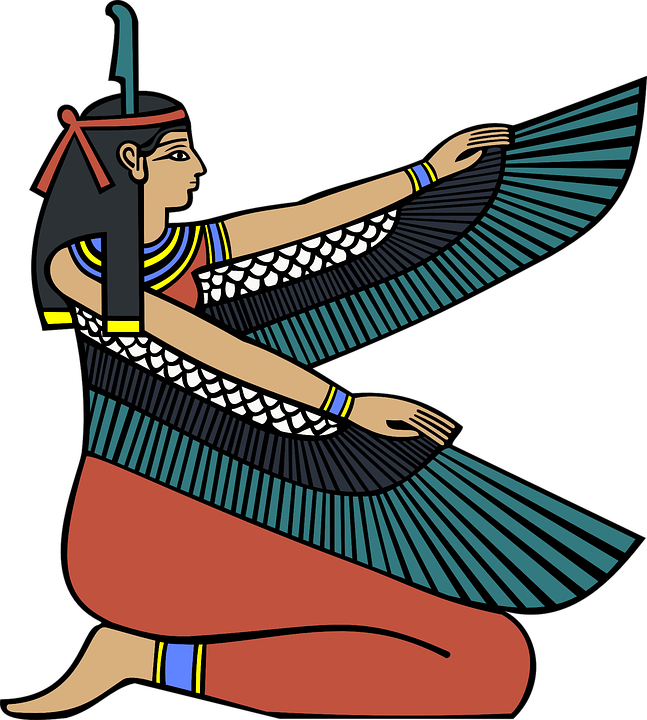
The feathers attached to this Egyptian queen’s arms symbolize power over the earth and flight into the afterlife.
In ancient Egypt, feathers or birds also signified the soul’s flight from Earth into the afterlife. Feathers were often shown in 2 layers, representing earth and heaven. Or they could be in 3 layers, representing the king, Earth, and heaven.

This is the gravestone for Lottie Sophia Reeves’ at Magnolia Cemetery in Charleston, South Carolina. It is unusual for two reasons. It is completely upright instead of lying on the ground and it features an Egyptian queen adorned with bird feathers.
Bird Symbols: On a Flower Bud

The finger on this hand is pointing slightly upward toward a wilting flower and a bird. The drooping flower and bud show that this woman’s life was cut short and her body has died. But the bird is a symbol of her soul, which has taken flight to heaven.
Bird Symbols: In a Nest

Birds that are watching over a nest of hatchlings is symbolic of parents that love their children.

Bird Symbols: On a Tree Stump

This young lady’s treestone has a detailed straw hat and a basket of flowers hanging on it. A bird rests on top. She died at the age of 4.
Tree gravestones are unique. Have you ever seen one? The first time I saw a tree gravestone at a cemetery, I did a doubletake. It looked so real that it blended in with the surrounding trees, appearing at first to be part of nature.
Treestones are often Woodmen of the World gravestones. Learn more about them HERE.

Many of the Woodmen of the World gravestones feature doves with olive branches in their beaks. Again, this is a reminder of the dove sent out from Noah’s ark that returned with an olive branch in its beak (Genesis 8:11).
The olive branch is a symbol of peace. We sometimes hear the expression, “extending an olive branch” to another person as a desire for peace.
Bird Symbols: Eagle

Eagles are frequently seen on military gravestones in the United States where the bird is the national symbol. It represents freedom.

The double-headed eagle is an ancient symbol. It has been associated with many empires including the Holy Roman Empire, the Seljuk Turks, the Byzantine Empire, and the Russian Empire.
The double-headed eagle was adopted as a symbol by the Scottish Rite Masonic Fraternity for 33rd Degree Masons. To Freemasons, eagles represent the omnipresence of God.

Scouting’s highest rank is Eagle Scout, an honor earned by demonstrating service and leadership, earning 21 merit badges, and by keeping the Scout Oath and Law – all by the age of 18. Below are some famous men who have earned the rank of Eagle Scout.
- Neil Armstrong – astronaut and first person to walk on the moon
- Steven Spielberg – film producer, director, and screenwriter
- William C. DeVries, MD – transplanted first artificial heart
- Philo Farnsworth – inventor of the television
- JW Marriott, Jr – President of Marriott Corporation and hotel chain
Bird Symbols: Rebekah’s Dove
The Daughters of Rebekah, also known as the Rebekahs and the International Association of Rebekah Assemblies, is an international service-oriented organization and a branch of the Independent Order of Odd Fellows.

Like many throughout the world, the Rebekahs consider the dove to be a symbol of peace. Rebekahs strive to bring happiness to others, through the mission of love and charity, and to promote “Peace on earth and goodwill to men.”

Bird Symbols: “Ruptured Duck”

This brass World War II cemetery marker features the Honorable Discharge symbol commonly known as The Ruptured Duck. It is patterned after the patch that was sewn onto service member’s uniforms to identify those who had been honorably discharged.
The purpose of the patch was to allow civilian police officers and military police to recognize the honorably discharged so they wouldn’t be arrested as deserters. It also kept active military members from walking away from their duty.

Frequently, Veterans often didn’t have any civilian clothes to wear when they left the military. There were two reasons for this.
First, military service members were banned from owning civilian clothing during active duty to discourage desertion. For this reason, they were allowed to wear their uniforms for 30 days after their discharge while arranging for new clothes.
Second, there was a national shortage of clothing during that period in American history.
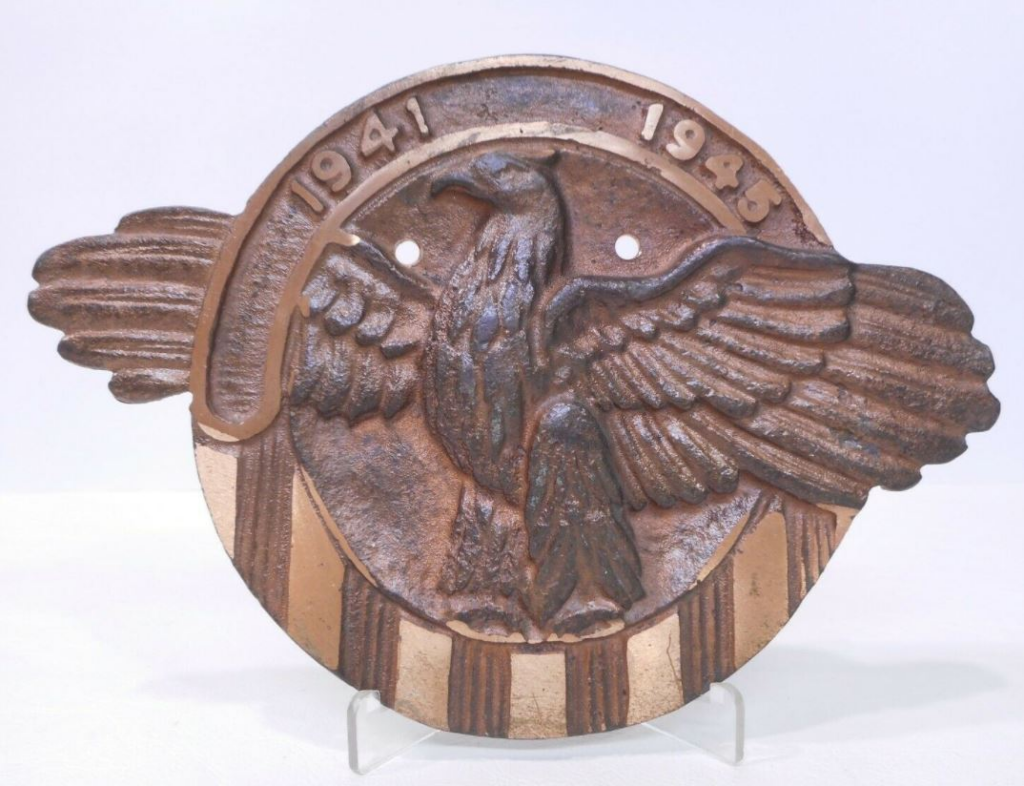
Why was the symbol on this cemetery flag holder called the Ruptured Duck? Well, that depends on who you ask. There are plenty of stories and rumors to explain, but here’s one of my favorites . . .
The bird was intended to be the US national symbol, the bald eagle, but some Veterans thought it looked more like a duck. It was facing to the right, the same direction doctors told patients to face when asked to cough during an examination for ruptures.
Got a rupture? You get an honorable discharge! And you get to wear the ruptured duck!
All Veteran’s inside-jokes aside, these World War II gravestone markers are meant to honor those who sacrificed to provide protection for their nation and promote freedom.
Bird Symbols: Birdlike Angels

This rounded face with a bird-like torso and wings marks the grave of widow Priscilla Weston, who is buried at Myles Standish Burial Grounds, in Duxbury, Plymouth, Massachusetts.
This curious symbol evolved gradually from winged-skulls to winged angels.

The copper in this bronze statue has given this beautiful angel a pretty green patina. She is accompanying the deceased to the judgment seat with a carefully kept record of mortal deeds.
Notice her headband, bird-like feathery wings, and her delicate fingers and toes. The wings symbolize the ability to move quickly heavenward.

What a tender sculpture! This girl seems to have complete trust and confidence in her guardian angel as she prepares to be escorted to heaven. Those large bird-like wings promise a quick flight to heaven.
Bird Symbols: Love Birds
Love birds are seen on gravestones for couples, usually a husband and wife who had been married for a long time. The love birds represent true and lasting love.

Carrie Paquette of Nashua, New Hampshire is a BillionGraves volunteer gravestone photographer. She loves the idea of taking GPS-linked photos with the BillionGraves app so the gravestones can be marked on a map, allowing others to find their ancestors.
But Carrie doesn’t stop there. She prunes shrubs and small trees. She checks for leaks in the water system. She weeds the perimeter and the graves. She plants flower gardens, waters young plants on new graves, and cleans up litter. She reports vandalism and other damage. Carrie even checks on the homeless living at the cemetery to see if they need anything and discourages them from leaving messes.

One of the most touching things that happened to Carrie at the cemetery was when an elderly man found her pruning the rose bush on his wife’s grave. At first, he thought that Carrie must have known his wife before she passed away.
When he found out that Carrie didn’t know his wife, but that she did it because she saw him visit the grave often and felt that it would be important to him, he cried.

The man told Carrie that his wife was the love of his life. He was worried because he had no descendants to maintain their graves after he died. Carrie told him, “I don’t have descendants either, so I understand.” She then offered to do it or to find someone else to carry it on.
Carrie said, “At that point, I was made an honorary descendant as he continued to repeat, ‘I love you!’
“He died soon afterward. But I still continue to care for the plants he planted and I always keep a love bird figurine there to represent the two of them.”
Birds of a Feather

Even today, if you were to go to a monument company to choose a headstone, you might be given a sheet of clipart filled with options for gravestone bird engravings.
From the Birds to the Family Tree
Birds engraved on headstones convey a message of peace, hope, and eternal flight to the final resting place. Whether it’s a dove, cardinal, eagle, or any other bird species, these designs reveal the powerful emotions of our ancestors.

They can also be great clues to finding more genealogical information. If your ancestor’s gravestone has a bird on it that represents a fraternal organization such as The Daughters of Rebekah, Boy Scouts of America, or the Freemasons, see if you can find the organization’s records in the community where they were buried.
If the bird is a symbol of faith, see if you can find a church near the graveyard with burial or attendance records. If the bird is a military symbol, look for military records.
More Gravestone Photos are Still Needed
We need your help with taking gravestone photos to help preserve history! When photos are taken with the BillionGraves mobile app, each picture is automatically tagged with GPS coordinates.

This allows families to easily find their ancestor’s final resting place at the cemetery so they can grow their family tree. It also allows future volunteers to see exactly what has already been photographed and what still needs to be done.
If you would like to volunteer to take gravestone photos with your smartphone click HERE to get started. You are welcome to take photos of gravestones at your own convenience, no permission from us is needed.
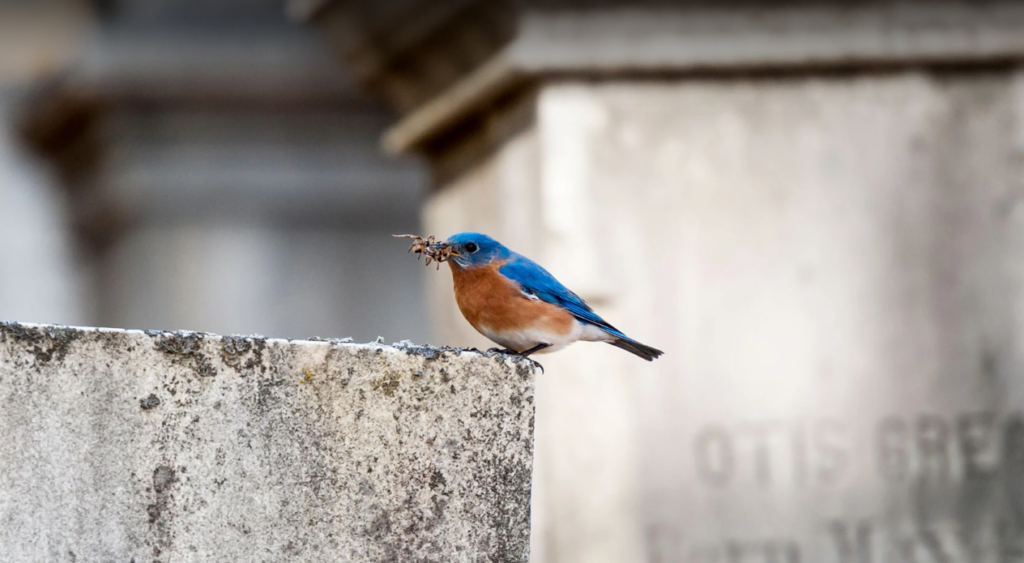
If you still have questions after you have checked out the resources above, you can email us at Volunteer@BillionGraves.com.
Would you like to lead a group in documenting a cemetery? Email us at Volunteer@billiongraves.com and we’ll be happy to send you some great tips!
Happy Cemetery Hopping!
Cathy Wallace

